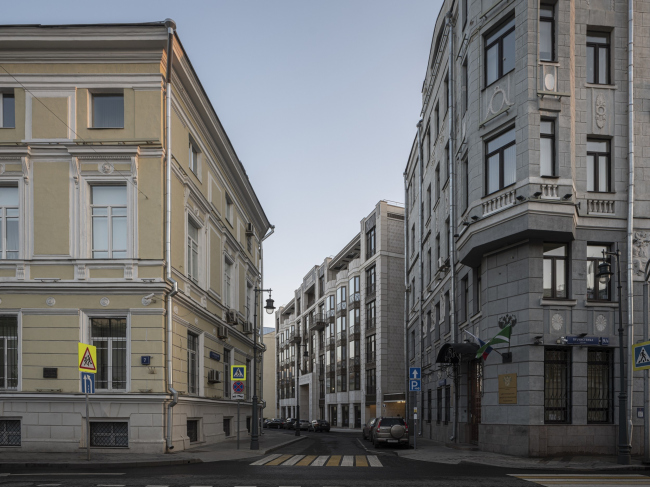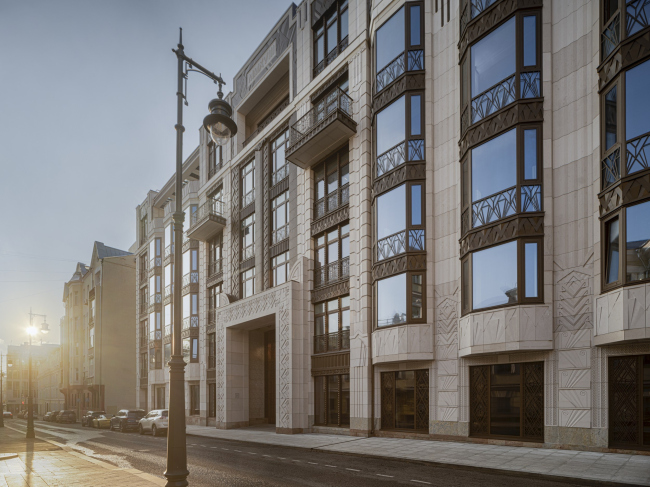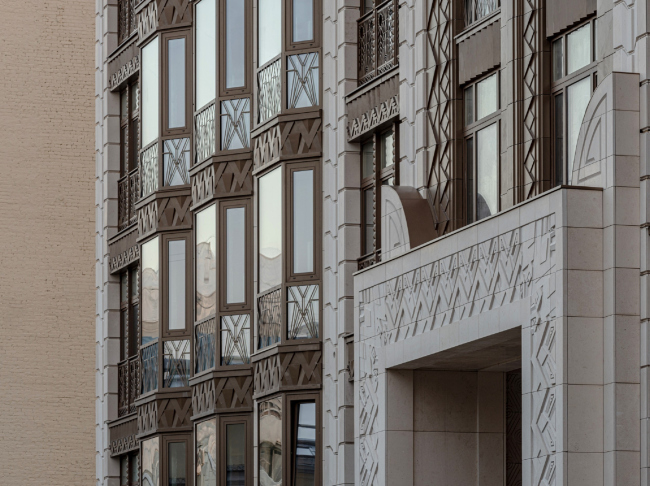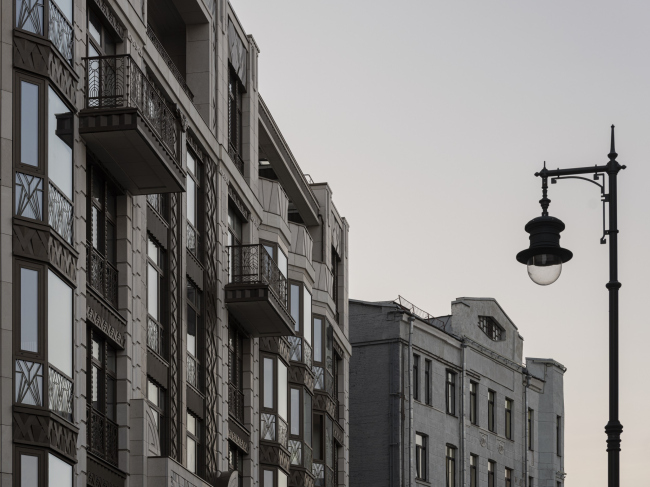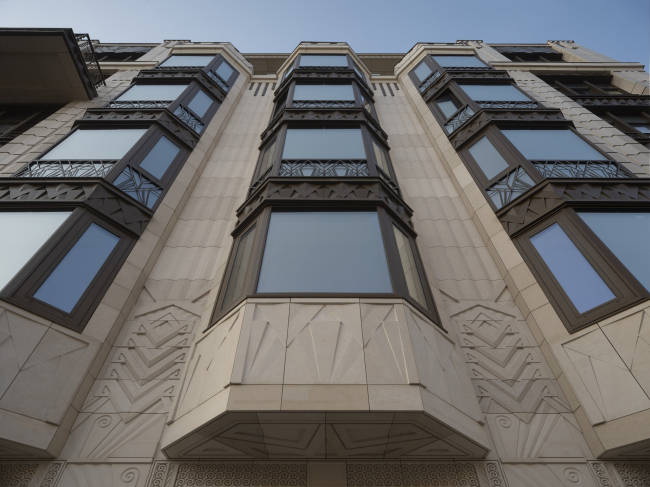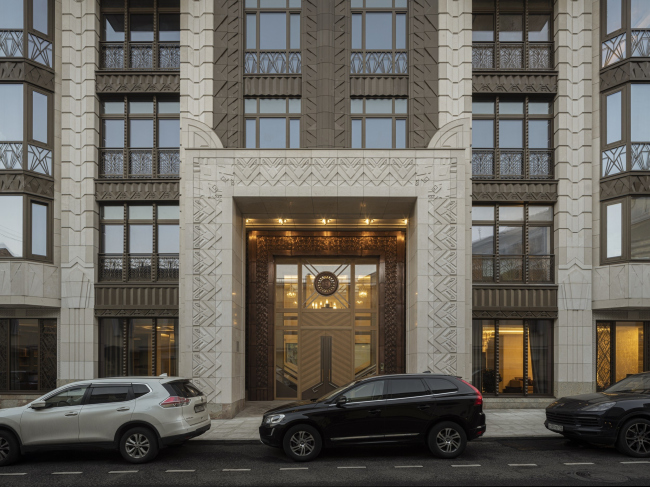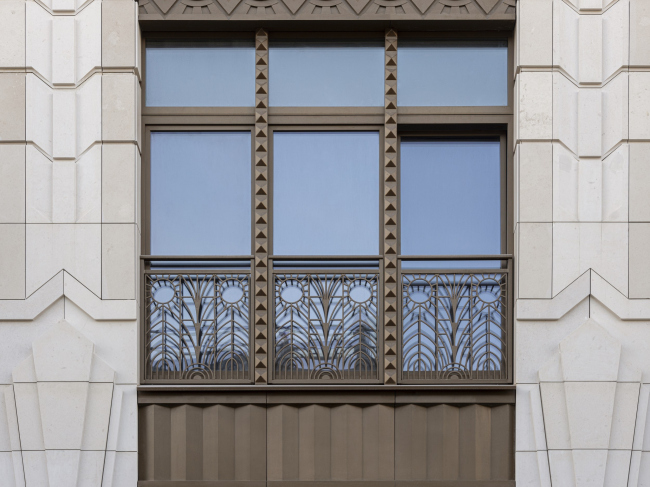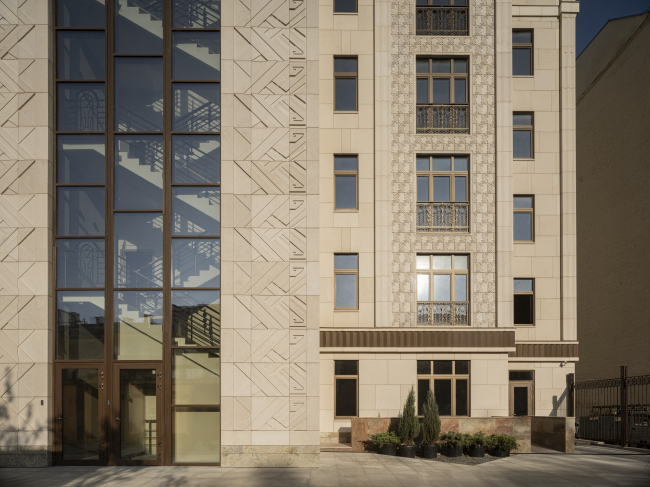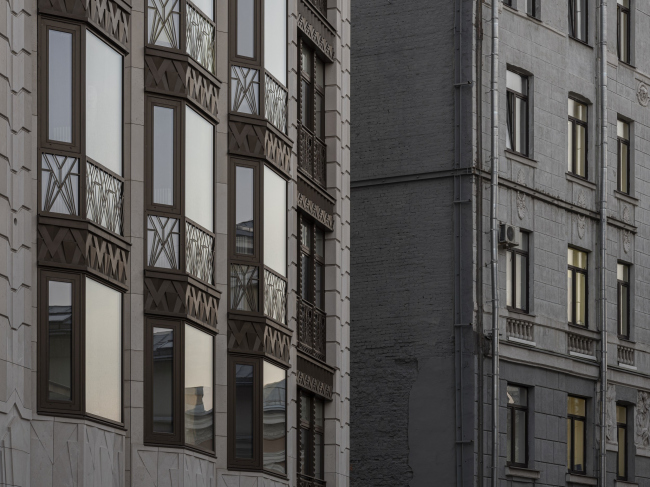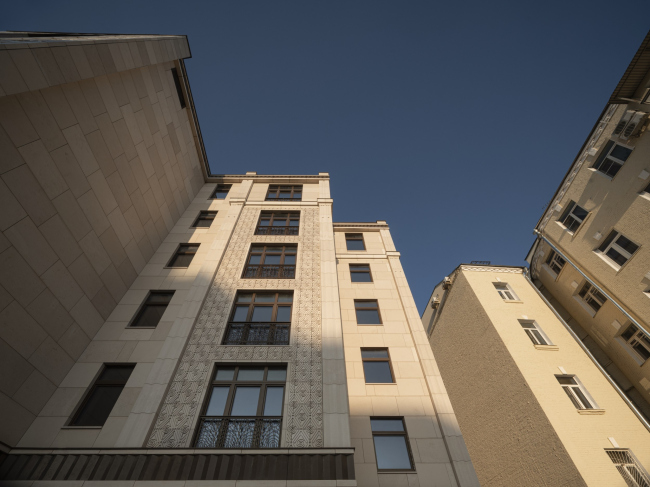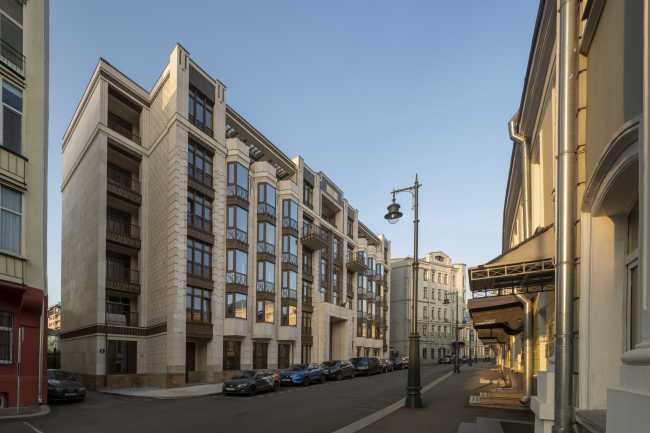|
Published on Archi.ru (https://archi.ru) |
|
| 03.02.2021 | |
|
The Fifth Element |
|
|
Julia Tarabarina |
|
| Architect: | |
| Ilia Mashkov | |
| Alexandra Kuzmina | |
| Studio: | |
| Mezonproekt | |
|
The high-end residential development in the Vsevolozhsky Lane features a combination of expensive stone and metal textures, immersing them into a feast of ornaments. The house looks like a fantasy inspired by the theater of the Art Nouveau and Symbolism era; a kind of oriental fairy tale, which paradoxically allows it to avoid direct stylization and become a reflection of one of the aspects of modern Moscow life. We already wrote about the project of the high-end residential complex in Ostozhenka’s Vsevolozhsky Lane back in 2016. The house is situated in the beginning of the “Golden Mile”, a five minutes’ walk away from Kropotkinskaya metro station, in the stead of a Soviet telephone hub built back in the 1980’s. Height- and redline-wise, it responds to the surrounding historical context; left and right of it, there are two tenements, designed by the architect Nikolai Zherikhov in the beginning of the 1910’s, one of them being an impressive neo-classic, the other, on the side street, unassuming Art Nouveau. Both neighbors are separated from the house by driveways, unlike the Soviet telephone station, which was pushed up against their firewalls. New caesuras in the continuous construction front opened the way for the rays of the sun, which shines from the south, from the side of the courtyard; they also let more light into the alley – the authors of the project explain. High-end housing project “Residence in Vsevolozhsky”Copyright: Photograph © Dmitry Yagovkin / provided by MezonproektImage-wise, however, the house does not directly respond to any of the neighboring buildings or the houses across the street, but develops its own theme based on accentuated ornaments on the verge of Art Nouveau and Art Deco, yet with some modern amalgamation, freedom of interpretation and geometrization of all of its elements. The market of Moscow high-end residential construction requires, on the one hand, a design solution that looks obviously expensive, based on costly materials, and carefully drawn, and, on the other hand, it must be something unique and unparalleled. Admittedly, the house in the Vsevolozhsky Lane meets both criteria. The facades are very rich, their main textures being natural limestone and metal (glass fiber concrete with a surface imitating patinated bronze). But, more importantly, Moscow has not yet seen anything like it.  High-end housing project “Residence in Vsevolozhsky”Copyright: Photograph © Dmitry Yagovkin / provided by Mezonproekt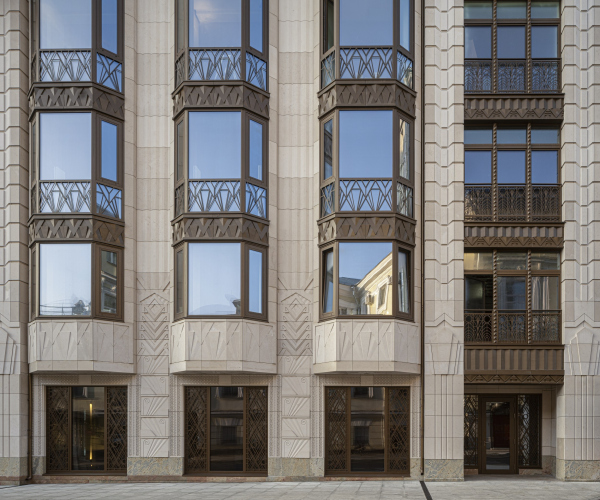 High-end housing project “Residence in Vsevolozhsky”Copyright: Photograph © Dmitry Yagovkin / provided by MezonproektGenerally, the house retains a rather conservative layout and typology: its plan has a U shape with two stairway risalits from the yard sides; in the center, the street is overlooked by an imposing entrance portal with a deep double-height lobby behind it. On either side of it, there are faceted verticals of the bay windows. The top tier above their ledges features the recessed balconies of the penthouse underneath massive canopies with skylights looking like large caissons. High-end housing project “Residence in Vsevolozhsky”Copyright: Photograph © Dmitry Yagovkin / provided by MezonproektThe structure, we repeat, is traditional, yet every element within it is enhanced a little bit more than usual. The bay windows form a faceted wave; the top recessed balconies, as if offsetting them, are deep and spacious, the entrance portal is really large. In addition, “metallic” structures are really numerous: combined with glass and stone, they form a weaving akin to jewelry, of course, adjusted for repeated enlargement. High-end housing project “Residence in Vsevolozhsky”Copyright: Photograph © Dmitry Yagovkin / provided by MezonproektHigh-end housing project “Residence in Vsevolozhsky”Copyright: Photograph © Dmitry Yagovkin / provided by MezonproektThis ornamental weaving became the fundamental technique that creates the impression of this house being special. There are virtually no empty planes on the main facade, and all the elements, even those in which the order-architecture base can be traced, are subjugated to the general “carpet” decorativeness. For example, the piers between the bay windows are likened to fluted pilasters, but they have neither bases nor capitals, apart from the “secession” metallic stripes at the top. The stone verticals may equally seem to be flutes or the wall surface’s response to the shape of the bay windows, because their relief consists of three-faceted ledges, and not of traditional grooves. High-end housing project “Residence in Vsevolozhsky”Copyright: Photograph © Dmitry Yagovkin / provided by MezonproektThe rock-face surface here receives beveled contours, forming a perspective illusion in the walls between the windows – a false ledge akin to the finds of the Pompeian style. The keystones do not crown the arches and do not form cornices, but only serve as decorative “crowns”, being placed closer to the base part. The curbs everywhere are huge, made of stone and bronze, significantly larger than their order prototypes, and work to enhance the light and shade. High-end housing project “Residence in Vsevolozhsky”Copyright: Photograph © Dmitry Yagovkin / provided by MezonproektProbably, the most traditional element here is the bronze diamond cut of the bindings of the triple windows; it also enhances associations with the Pompeian style and Art Deco. High-end housing project “Residence in Vsevolozhsky”Copyright: Photograph © Dmitry Yagovkin / provided by MezonproektEverything that cannot be explained in one way or another from the point of view of the architecture of orders is subordinate to the ornament, which can be conventionally divided into two types: surfaces completely covered with curls very much in the spirit of Gustav Klimt – and a pattern composed of zigzags and slanted plates, each of which peeps out from under the next one. They look like “hollow relief” (or “cavo relievo” the kind of relief that is based on voids rather than protrusions, a technique first used in Ancient Egypt), depicting growing crystals. What is also curious is the fact that the large ornament responds to the spatial pattern of specks of light on the skirting boards of the staircases in the sunlight. High-end housing project “Residence in Vsevolozhsky”Copyright: Photograph © Dmitry Yagovkin / provided by MezonproektAnother important detail is that the “lamellar” relief covers not just the front surfaces: the relief decoration of the house is applied everywhere and covers, among other things, the lower planes of the bay windows, so a passer-by, raising his head, will also see an ornament. “It was essential for us to treat the surface of the house as processed and dynamic, revealing the depth of the stone surface” – emphasizes the leader of AB “Mezonproekt” Ilia Mashkov. High-end housing project “Residence in Vsevolozhsky”Copyright: Photograph © Dmitry Yagovkin / provided by MezonproektSometimes, the lamellar pattern “merges” with the curls, the scrolls becoming larger in these instances, and their contour freer. Between stone and bronze, the “layered crystals” are roughly halved – they are present here and there, responsible for the integrity of the approach and the connection between the two main materials of the façade. Essentially, they keep the entire house together. All the patterns respond to the joints between stone and bronze plates, in many cases including them into the general rhythm as its quite natural part – it may seem that the house is being formed before our eyes from individual “scales”, thus making full use of the modern technology of interaction between the ventilation facade and its cladding.  High-end housing project “Residence in Vsevolozhsky”Copyright: Photograph © Dmitry Yagovkin / provided by Mezonproekt High-end housing complex “Residence in Vsevolozhsky”Copyright: Photograph © Dmitry Yagovkin / provided by Mezonproekt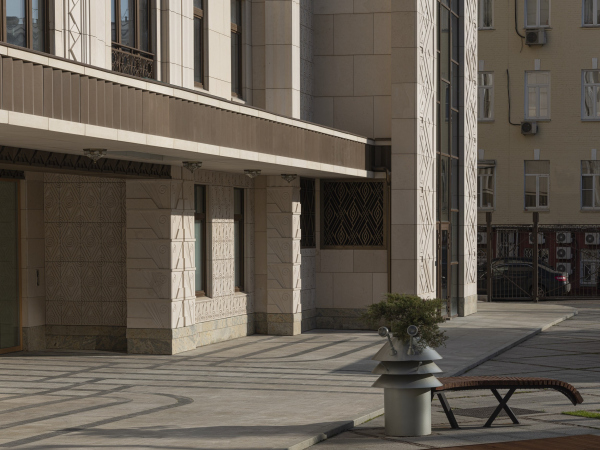 High-end housing project “Residence in Vsevolozhsky”Copyright: Photograph © Dmitry Yagovkin / provided by Mezonproekt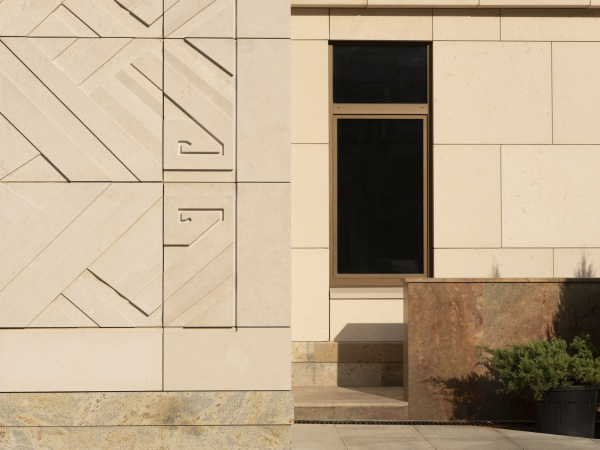 High-end housing project “Residence in Vsevolozhsky”Copyright: Photograph © Dmitry Yagovkin / provided by Mezonproekt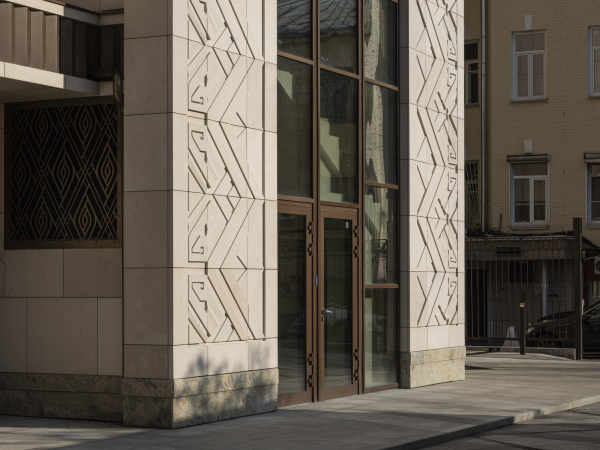 High-end housing project “Residence in Vsevolozhsky”Copyright: Photograph © Dmitry Yagovkin / provided by MezonproektThe relief motifs are continued in the patterns of bronze lattices – on the ledges of the bay windows they are looser and more abstract and geometric, figurative sunflowers appearing in the planar verticals, designed in a more traditional way. But then again, figurative can also be traced in the basic motive of the bay windows – generalized human figures, the circle of which forms the sun in the house logo proposed by the architects. 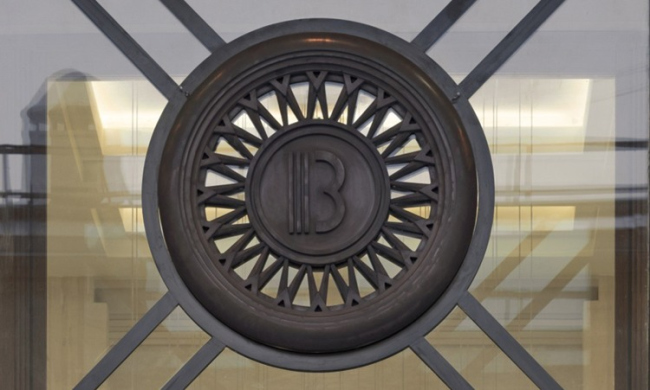 High-end housing project “Residence in Vsevolozhsky”Copyright: Photograph © Dmitry Yagovkin / provided by MezonproektThe circle is meant to symbolize the community of residents, while the conditional “origami” shadows, which can be seen almost everywhere on the facades, albeit in a coded state, serve as the reminder of the main idea. The outline of the “human figure”, dissected very much like a pentagram, is even slightly reminiscent of the outline of Le Corbusier’s “Modulor”, which suddenly redirects us from the conditional “secession” to the architectural search of more recent times. High-end housing project “Residence in Vsevolozhsky”Copyright: Photograph © Dmitry Yagovkin / provided by MezonproektA denser and more detailed version of the ornament is continued in the copper panels above the entrance and in the lobby – here, closer to the entrance, real metal is used. The gradient shades of its precious “red” color are well read thanks to the close “brocade” weaving of multidirectional curls, working to create an image of an expensive “frame” or “lining” of the house.  High-end housing project “Residence in Vsevolozhsky”Copyright: Photograph © Dmitry Yagovkin / provided by Mezonproekt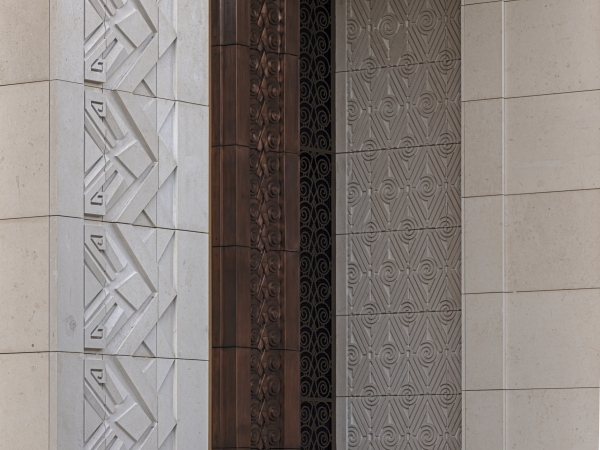 High-end housing project “Residence in Vsevolozhsky”Copyright: Photograph © Dmitry Yagovkin / provided by MezonproektThe yard façade is more laconically designed: on the one hand, this is dictated by the logic of the rear façade itself, on the other, there are more large ledges and projections here, which makes the structure of volumes resonate with the neighboring houses and is thus perceived as a contextually meaningful part of the “Moscow yard”. High-end housing project “Residence in Vsevolozhsky”Copyright: Photograph © Dmitry Yagovkin / provided by MezonproektHere the cutting of the stone slabs takes on a noticeable resemblance to a rock-face surface, and, unlike the main façade, “synthesized” by ornaments, here the decorated and laconic surfaces are rather contrastive to each other. At the same time, the large-scale frames around the staircase risalits continue the theme set by the entrance portal, giving the house quite a solemn appearance: even from the yard side it looks “like a palace”. Maybe even some oriental, even Persian palace – first of all due to the neoclassical character of the dual composition with a pier in the center. 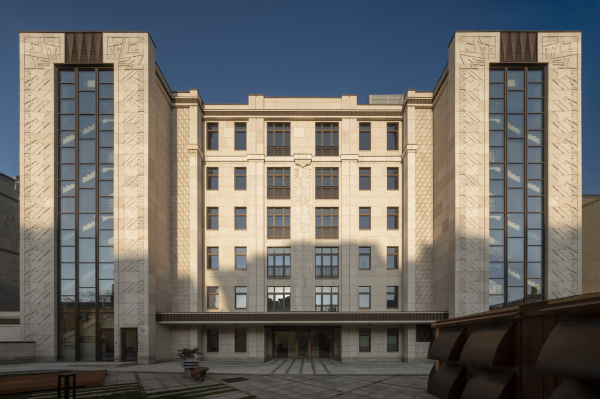 High-end housing project “Residence in Vsevolozhsky”Copyright: Photograph © Dmitry Yagovkin / provided by Mezonproekt High-end housing project “Residence in Vsevolozhsky”Copyright: Photograph © Dmitry Yagovkin / provided by MezonproektThe central pier is there on the main façade as well, where it is a little less prominent. Its appearance is conditioned by the structure of the house, consisting of two sections with one entrance in the middle.  “Residence in Vsevolozhsky”. Plan of the 1st floorCopyright: Photograph © Dmitry Yagovkin / provided by Mezonproekt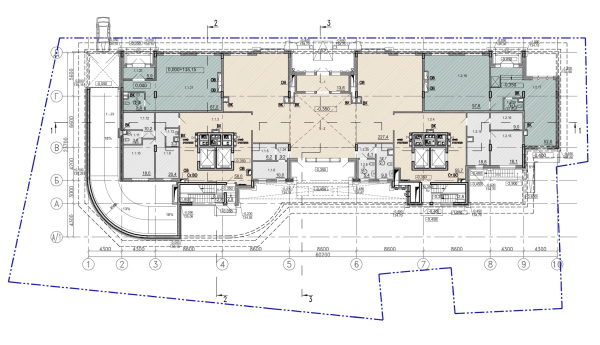 “Residence in Vsevolozhsky”. Plan of the ground floorCopyright © Mezonproekt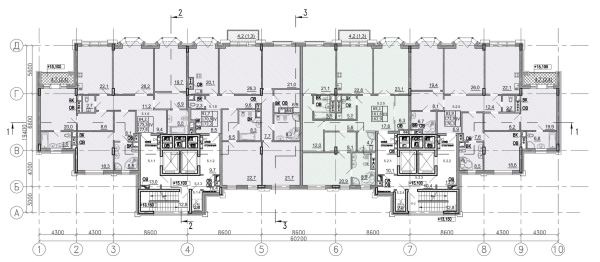 “Residence in Vsevolozhsky”. Plan of the typical floor © MezonprojectCopyright © Mezonproekt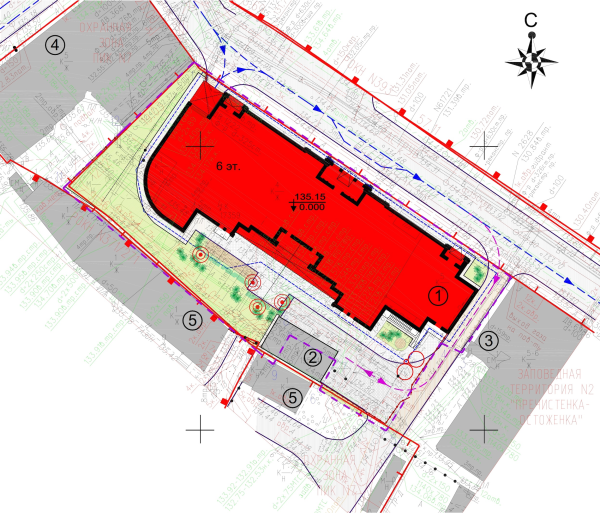 “Residence in Vsevolozhsky”. Master planCopyright © Mezonproekt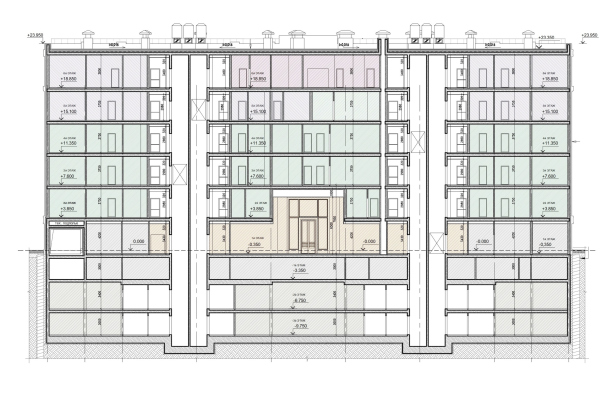 “Residence in Vsevolozhsky”. Section viewCopyright © Mezonproekt “Residence in Vsevolozhsky”. Section viewCopyright © Mezonproekt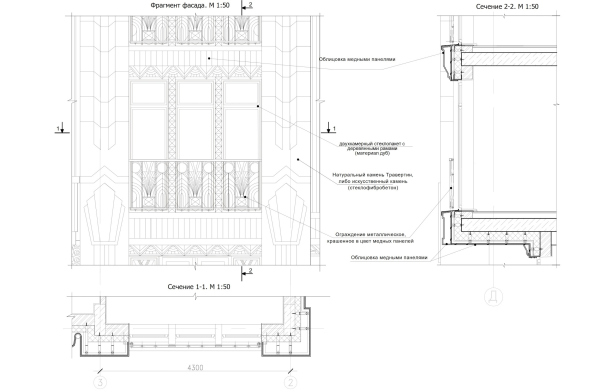 “Residence in Vsevolozhsky”. Fragment of the facade with a section view© MezonprojectHowever, the main effect that this house produces is the theatrical one. The Art Nouveau and neo classical buildings, standing near, vividly demonstrate that this house is not stylization and not historicism in the direct sense of this word, and not even another experience with bourgeois Art Deco. Most of all, it resembles the illustrations and scenography of the Symbolists, sketches of costumes and backstage; a curtain for some “Egyptian Nights”. The fantasy component is very strong here – trying to embellish the façade surface, the architects are emphasizing its role as some sort of a screen, upon which you can draw in a freehand manner. We will note here that this approach makes the house look like more than just a modern one: this version of craving for sensations which makes you turn the surroundings into a theater stage and provokes some pretty loose attitude towards the rules, so visible in houses that are more than a hundred years old, is specifically characteristic of this day and age. It is this approach that opposes the rules with what I would call “materiality riot” – if not in color, then in lines and textures, and ledges and recessions. High-end housing project “Residence in Vsevolozhsky”Copyright: Photograph © Dmitry Yagovkin / provided by MezonproektIf we are to compare this house with earlier houses designed by Mezonproekt in the spirit of respectable historicism – for example, the housing complex “House near Academy of Sciences” or with the house on Veresaeva Street – we will see a much freer construction, to some extent based on independence of the ornaments with a tendency to self-development. Although the house looks “Egyptian”, it does not have, strictly speaking, a single recognizable Egyptian detail about it, neither lotus, nor scarab (even though the wings, open wide in a “scarab” fashion over the central pier on the yard façade, do evoke some certain associations). The scrolls on the walls look more like the wigs and the beards of the winged Assyrian oxen from the Pushkin Museum. This house is not a stylization – rather, it is a fantasy inspired by the fantasies of the Symbolists, who in turn were inspired by an oriental tale: radiant, desperately luxurious, in many ways deliberately mysterious – the sum of those emotions that often evoke in us the most generalized idea of “the Golden Age” interrupted by the First World War. To be exact, that time is adequately termed “Silver Age” – but many people tend to think of it as the “Golden Age”, some sort of lost paradise, some sort of candy fairytale. Probably, this is the kind of fairytale that the house in Vsevolozhsky Alley must become. Well, then, it is a really understandable in the Moscow context experiments with feelings – both resident’s and passers-by. |
|
